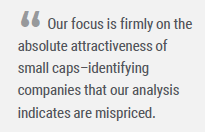
Mark Costa is a Director, Investments Group and a Senior Analyst on the Industrials Team, covering aerospace and defense, industrial conglomerates and industrial machinery/engineering. He is a member of the Small- Cap Investment Committee, where he also serves as a Product Coordinator. Mr. Costa is a limited partner of the firm’s parent company. He holds a BS in finance with distinction from San Diego State University. Mr. Costa joined Brandes Investment Partners in 2000.
Given the recent outperformance of U.S. large cap stocks compared to small caps, we spoke with Mark Costa, CFA, to understand challenges and prospects in the small cap market. He delves into performance trends of small caps versus large caps and the nuances of investing across global markets. The conversation offers insights into Brandes’ approach to finding value in both U.S. and international small caps. Mark has 24 years of experience and has been with Brandes since 2000.
As a student of investment history who has been investing for nearly 25 years, it always catches my attention when phrases like “the new normal” are being thrown out. It has been an amazing run for large caps, particularly in the U.S., but when you break down the performance of the S&P 500, performance has been driven by the top seven companies (i.e., the so-called “Magnificent Seven”). And while it is impossible to predict how the future may unfold, the past decade of large cap outperformance reminds us of historical patterns, such as during the Nifty-Fifty era and pre dot-com bubble times, where similar trends were observed before a shift back to small caps. When we consider the risk-return profile, small caps, by their nature, tend to carry more risk and in theory should yield higher returns compared to large caps. This is reflected in historical data, which shows small caps outperforming large caps over extended periods.1
Current market dynamics reinforce this view. The relative valuation gap between large and small caps, based on metrics such as enterprise value to sales, price to earnings, price to book, and price to cash flow, is near historical extremes. On an absolute basis, if we look at the Russell 2000 Index, its price to earnings and price to sales metrics are near thirty-year lows, suggesting a significant undervaluation of small caps.
There is also a behavioral aspect to consider. Markets often exhibit phases of high investor enthusiasm for certain asset classes, leading to their outperformance. This enthusiasm, while possibly justified, tends to drive valuations to levels where future returns are pulled forward. As a result, prolonged investment in such asset classes can lead to periods of underperformance as markets adjust back to equilibrium.
Conversely, when an asset class is out of favor, like small caps currently, it presents opportunities. When companies continue to generate revenue, earnings, and cash flow, and if they grow at a rate that is faster than the rate at which the stock price appreciates, it can lead to value dislocations that long-term investors can seek to exploit. Moreover, the longer that sentiment period lasts, the greater that valuation gap can become. This dynamic seems to be expressing itself in the small cap universe, where we are seeing a rich environment for value investing, characterized by an abundance of what we would consider undervalued opportunities.
Our focus is firmly on the absolute attractiveness of small caps―identifying companies that our analysis indicates are mispriced, with robust business models and strong balance sheets that can weather economic uncertainties, so the long-term return potential can express itself.

The small cap landscape varies significantly across different geographies and industries, but there are underlying commonalities due to prevailing market sentiments (i.e., surrounding large cap vs. small cap, value vs. growth). Both in the U.S. and internationally, we're finding a wealth of potential opportunities in small caps. These include companies trading at attractive valuations, with solid balance sheets and durable business models.
In terms of where Brandes is finding the best value potential, we are finding a richer opportunity set internationally, in part because of how large the asset class is. There are about 10,000 small cap companies in the global small cap opportunity set, and roughly 7,000 are outside of the U.S. Additionally, there are few analysts covering these markets. Therefore, you can look at international small cap as a very large pond with few fishermen, which can result in inefficiencies and larger margins of safety (the margin of safety for any security is the discount of its market price to what the firm believes is the intrinsic value of that security).
Another difference with the international small cap universe is that we find a larger number of primary businesses―leaders in important industries. This is particularly true in countries with smaller populations, where a company can be a market leader yet still classify as a small cap due to the overall market size.
In the U.S., the small cap opportunity set is smaller (about 3,000 companies), due to the country’s size relative to global gross domestic product. It also has a greater number of secondary type businesses. This means that we have to be very selective with U.S. small cap investing, because there are many companies with weaker business models (e.g., they are a supplier to a large customer, in the entrepreneurial phase, or have a lot of leverage on their balance sheet). While the investment universe is not as attractive as it is internationally, we are still able to construct a robust portfolio because we are highly selective. Our U.S. small cap portfolio focuses on companies with durable business models and strong balance sheets―an essential factor in a market where many Russell 2000 companies have taken on increased leverage and a significant portion are not generating positive earnings. In fact, the Russell 2000 has a 90% debt to equity ratio, and 46% of companies in the index do not generate positive earnings.2 Our portfolio is 40% net cash, which means there is more cash on the balance sheet than debt. It has an 8% debt to equity ratio on an aggregate basis (excluding financials), and 90% of the portfolio is generating positive cash flow.
In summary, while the international small cap market offers a richer opportunity set due to its larger size and inherent inefficiencies, the U.S. market, despite its risks, presents valuable prospects for an active, discerning investor, especially given the poor sentiment around small caps. One thing is consistent across our small cap portfolios―our approach to uncovering potentially undervalued companies with solid fundamentals.